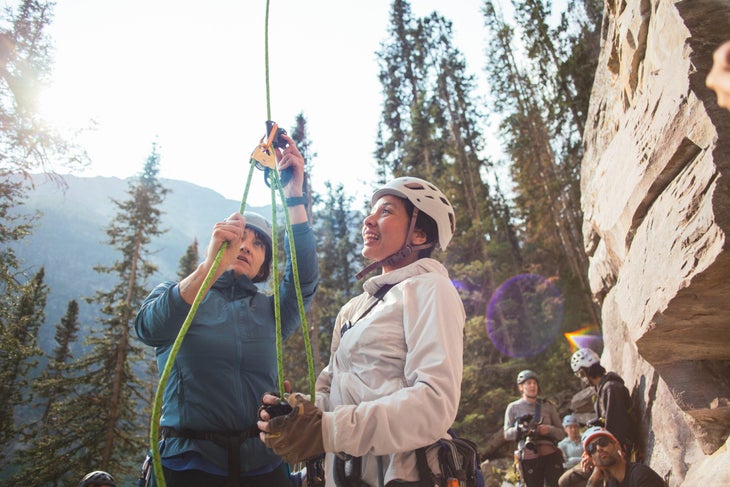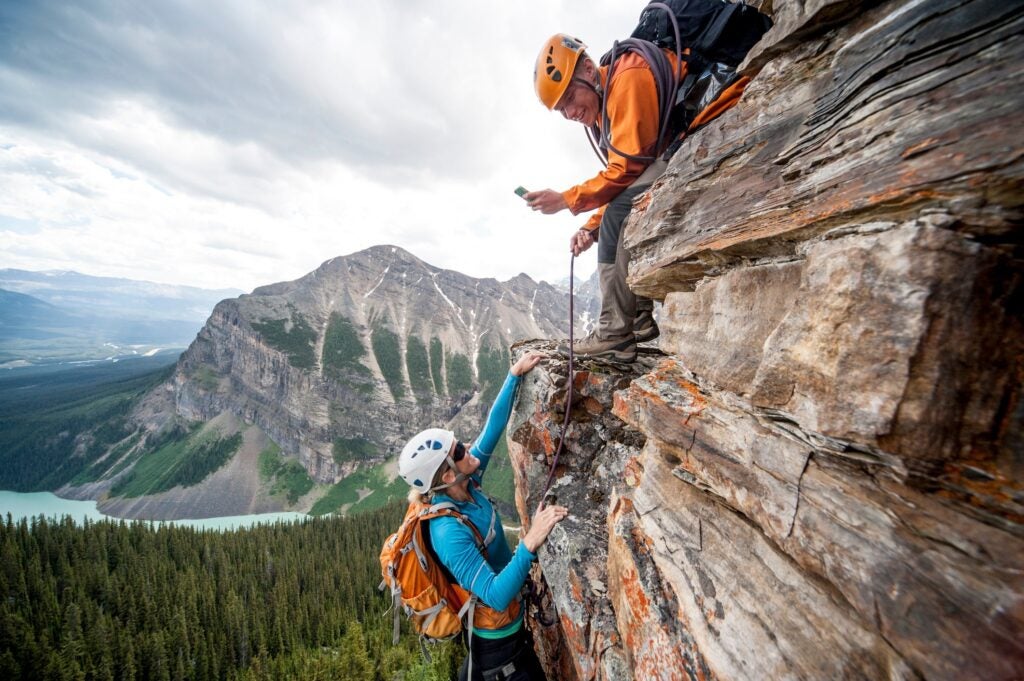No products in the cart.
Outdoor Adventure
The Future of Rock Climbing Instruction May Be on Instagram
Earlier this year, a popular guide and social media personality, @alpinetothemax, uploaded a video to Instagram. It showed a climber on the First Flatiron, above Boulder, reeling in rope as he belayed a follower, who was off screen, through a single redirected piece. Apart from a frowning-face emoji censoring the belayer’s face, the shot didn’t seem out of place among the thousands of other “tech tip” videos populating climbing social media. “This post is not meant to dox this individual, but to provide an example for others to see their own blind spots,” part of the caption read. “Keep it constructive and productive.” Then the comments section exploded.
One user wrote that, “if you really care about their safety (and really felt that it was at risk), wouldn’t you have intervened in the moment rather than posted a secret video?” Another climber posted: “When I started climbing I was called out by a guide after an AMGA class for giving a bad belay. I nearly quit climbing on the spot because I was so humiliated… The fact that you made this so public is a really low blow. If you cannot give feedback to the person’s face, don’t post it.”
@alpinetothemax, whose real name is Max Lurie, is a 36-year-old guide based in Boulder, CO. Over a decade or so of guiding, Lurie’s Instagram following has swollen to 85,000 followers, most of whom have gravitated towards his tech tip posts. Lurie is one of many American guides who have begun posting climbing tips to their social media pages.
“It’s a hard industry to make a living in,” Lurie told me of guiding, over the phone. Posting such content “does bring the clients in,” he acknowledges, “but that’s not the only reason I do it. It’s just a way of giving back to our community. But then, that’s where the good things stop. With posting come all the problems of social media.” Including, he says, getting into hot water for posting a video using recreational climbers as an example of what not to do. “I got kind of crucified for that one.”
Lurie’s post and its fallout may be a telling waypoint in a larger shift in which climbing is taught—at least partially—on a screen instead of a cliff. Historically, climbers cut their teeth in a dangerous sport with the help of guides or mentors or a select set of instruction books, like John Long’s “Climbing Anchors” or the perennially updated “Mountaineering: Freedom of the Hills.” Now, a new climber can follow, scroll, and like their way towards proficiency. Online, a seemingly limitless amount of information awaits.
The shift poses a set of questions important for our sport: Can aspects of climbing be taught online? Who gets to post, and why? How do new (and old) climbers sort through the wealth of content in order to tell the difference between the hacks and the experts?
Online learning levels the playing field, giving those who face social or financial barriers access to knowledge once passed from person-to-person. “The landscape’s really changed. [A guide’s] reach is now much further,” says Dale Remsberg, a 51-year-old IFMGA guide based in Lafayette, Colorado. Such content should be taken with a grain of salt though. “The responsibility lies on the person seeking out what to learn and how to learn,” notes Silas Rossi, an IFMGA guide who has started the Ascend Membership, an online mentorship program designed to augment in-person learning. Climbing is “very unforgiving, and it’s really hard for people to understand how much risk they’re assuming when they are just starting to understand what risks are really involved,” he points out. And there’s an added danger in misapplying a technique taken from a short video. “The risk is somebody that doesn’t know much about climbing uses all of your content and they misapply the technique and get killed. So, that’s scary,” Remsberg says. “It’s totally a recipe for disaster,” Lurie cautions.
An increased number of gyms means that climbers with the ability to climb difficult grades may never venture outside. And those with the strength to do so have very little knowledge of ropework and belaying. This rise in physical standards has quickly outpaced traditional methods of how climbers learn, sometimes with disastrous results. “Here in the Gunks we have an average of one death per year, and it’s not infrequently a new climber leading, or learning to climb with friends,” Rossi notes.
Jeff Yoo, an ER doctor as well as an experienced boulderer and sport climber, has noticed that “there’s such an influx of new climbers; [but] there’s not as many mentors around. And I think that’s a big issue in the outdoor climbing space we haven’t really solved.” This summer, Yoo, who has repointed multiple 5.13b’s and bouldered V12, began traditional climbing, a shift in disciplines he admits sent him into cognitive overload. “I made so many mistakes in my first days,” he recalls. Attempting the Oracle, a traditional route in Squamish that “could potentially become R- or X-rated” during an onsight lead like Yoo’s, according to MountainProject, Yoo took and weighted his third piece sideways, which failed and zippered out his lower protection. He hit his belayer before hitting the ground. Both were OK, and Yoo posted a video of the fall on his Instagram page. Looking back, Yoo realizes it was his assessment of risk, not his strength, that was unreliable: “You don’t know what you don’t know.”
Yoo doesn’t think that “online tech tips could ever replace the real life experience of actually placing protection and climbing above it. But it’s clear that more and more climbers are partially—or wholly—substituting in-person guiding or mentorship with some kind of online content.
All this begs a few questions: what are the safest and best ways for instructors to provide online learning, and what are the safest and best ways for climbers to use this new kind of information?
Everyone I spoke to for this article stresses that responsibility still falls on the user. “The thing I tell my students is to be skeptical,” Lurie mentions. “Don’t just take any information at face value.” Marc Chauvin, the former president of the AMGA and author, with Rob Coppolillo, of “The Mountain Guide Manual,” recommends paying for online subscription services to buy into a progression of learning, in addition to following tech tips from free Instagram handles. Remsberg cautions that “you can only learn so much online.”
But anyone can post content; for a new climber, it’s hard to decipher who is an expert and who isn’t, and how to filter through and apply complicated techniques. “There’s no oversight,” Lurie notes. Remsberg has noticed that “some of the pro climbers trying to increase their following are posting their own tech tips and some of them are wrong and flat-out dangerous.”
While niche techniques, like belaying a follower with a Mini Traxion, or simul rappelling might garner more clicks, oohs, and aahs than basic fundamentals, these nuanced practices are hard to boil down into thirty-second Instagram clips and can easily be misapplied with disastrous results.
Sean Sarkar, a climber with two years of ice climbing and a year of trad leading under his belt, who has used tech tips, subscription-based learning, and in-person guiding to progress, tries to ask the question: “Is this something different than I’ve seen before but is totally safe, or is this something that’s actually dangerous?”
For guides, especially in the United States, Instagram helps to augment wages, appease sponsors, and generate interest in a business. In the United States, guides are typically paid less than their European counterparts, and work is more sporadic. “In [European] culture it’s very common to hire guides,” Remsberg points out. “Those guides always had a steady stream of work. They haven’t had to market themselves. I’ve had to be hungrier and figure out ways to gain clients and make money.” And where new techniques were once driven from outside learning, or from hard-earned information gleaned from accidents, there’s a potential they’re now being created to feed and maintain a social media presence, that some influencers are reinventing wheels just to remain relevant in a growing cottage industry. But the more unique the tech tip, the less applicable it may be.
To counter this, Rossi recommends paying attention to the fundamentals—even if they’re boring—and building good habits early. If you spend money on guiding and instruction (and there are plenty of climbers who never will), try to invest early in order to build solid foundational habits that will accompany you for the remainder of your climbing career.

So far, the new frontier of online instruction seems to have policed itself. “Within the guiding community there’s pressure,” Lurie says. “These people who have a big social media presence? They’re putting themselves out there. They know their colleagues will be watching, so there’s professional pressure.” Lurie mentions his reputation now precedes him at crags, which forces him to be sharper with his systems in his everyday guiding.
Even if education is the motive, the newfound ability for guides to film recreational climbers making errors or using outdated techniques should raise questions within the profession. Some level of knowledge is necessary in a deadly pastime. But on the other hand, so is learning from your own mistakes. There’s undeniable value in learning from others’ errors. Airline pilots in training review cockpit recordings of doomed planes to scour what went wrong; militaries implement after-action reviews to quickly absorb lessons from mistakes made in the field. None of these occur on such a public platform, however.
Finding the balance between education and shaming remains essential for climbing, and finding constructive ways to impart the knowledge should be paramount within the guiding community. “We definitely had a strong shaming vibe,” Rossi notes of climbing culture’s old-school education aesthetic.
It’s not difficult to imagine a future where the AMGA implements stricter guidelines for its members who post tech tips, cautionary videos, and information online, or extends their code of conduct to further encompass the internet, where so many beginners are now turning for information. Until then, perhaps it’s best to give weight—just this once—to a comment posted on the internet: “I would suggest following the rule in river sports to always post positive—showing the best way to do something is the most effective teaching tool.”

